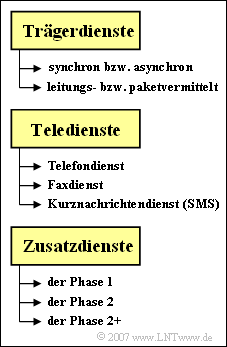Exercise 3.2: GSM Services
Any Public Land Mobile Network (PLMN) must provide the fixed network infrastructure and so-called Interworking Functions (IWF). This is the only way to provide the desired services at the user interface.
GSM services are divided into three categories:
- Bearer Services,
- Tele Services,
- Supplementary Services.
The basis for data transmission is the carrier services, where the maximum data rate is $\text{9.6 kbits/s}$ .
Teleservices are end-to-end services. The most important of these are:
- the telephone service,
- the fax service,
- the short message service (SMS).
Various ancillary services belong to each phase of GSM development:
- call display, call forwarding and caller ID in phase 1,
- call waiting (Call Waiting), hold (Hold) and conference call (CONF) in phase 2,
- General Packet Radio Service (GPRS), High Speed Circuit-Switched Data (HSCSD), Enhanced Data Rates for GSM Evolution (EDGE) in Phase 2+.
Hint:
- The exercise belongs to the chapter "General Description of GSM".
Questions
Solution
(1) Correct is the proposed solution 1:
- Carrier services form the basis for data transmission.
- They provide the technical means to transport data in a secured manner.
(2) Correct is the proposed solution 3:
- The maximum data rate for GSM data transmission is $9.6 \rm kbit/s$.
- There are synchronous and asynchronous as well as circuit-switched and packet-switched data transmission.
(3) Correct are proposed solutions 1 and 3:
- Proposition 2 is incorrect: The terms synchronous and asynchronous play a role only in connection with carrier services.
(4) Correct are the proposed solutions 2 and 4:
- In contrast, call forwarding belongs to GSM phase 1 and General Packet Radio Service (GPRS) to phase 2+.
(5) Correct is the proposed solution 2:
- High Speed Circuit-Switched Data (HSCSD) was introduced as a circuit-switched transmission technology.
- In contrast, General Packet Radio Service (GPRS) operates as packet-switched and Enhanced Data Rate for GSM Evolution (EDGE) can be described as circuit-switched data service.
